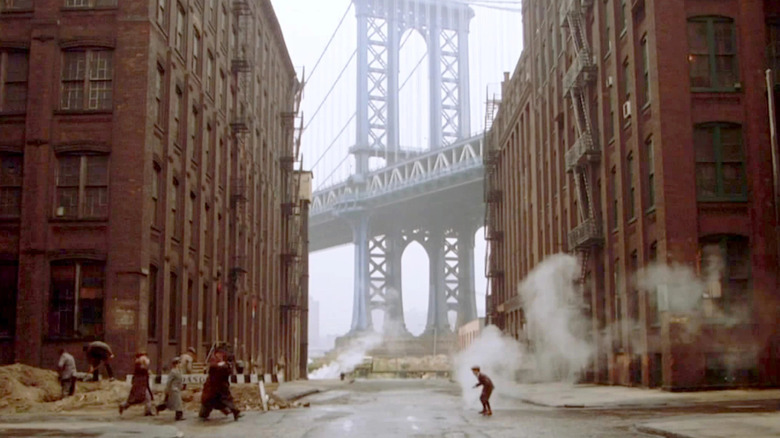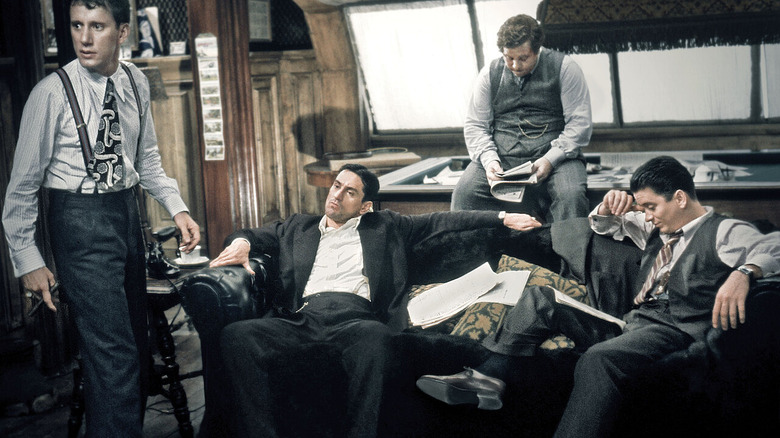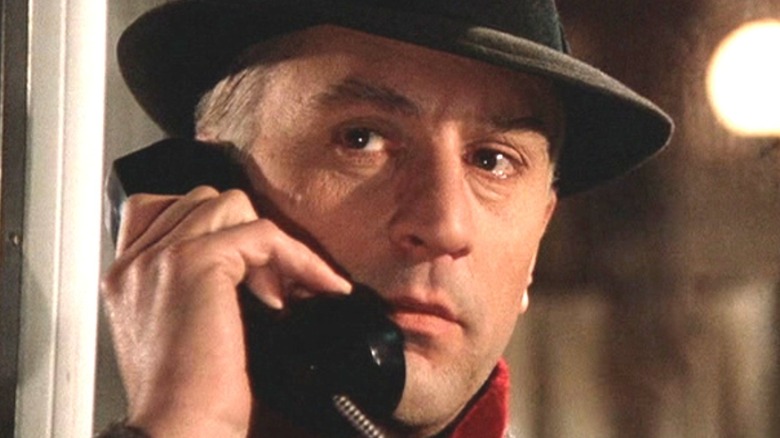Sergio Leone Had To Fight For The Rights To Make Once Upon A Time In America
Sergio Leone only made seven films in his career, but the best of them sealed his reputation as one of the most stylish and influential directors of the 20th century. Like Wim Wenders with the road movie and Paul Verhoeven with sci-fi, he used genre to view America through the eyes of an outsider, using his operatic violence and gallows humor to put his distinct slant on two of the most American genres of them all: the Western and the gangster movie.
Leone's "Dollars" trilogy, ostensibly set in the States but shot in Spain, made the Old Hollywood Western formula look prehistoric. The films centered on morally dubious antiheroes and even worse villains, with the camera thrillingly zoomed in on the faces of some of the grittiest, sweatiest desperados seen on screen at that point. His intensely framed and edited visuals were matched by the incredible work of Ennio Morricone; I think it's fair to say Leone's films would be diminished by half without the collaboration of the composer.
Once the "Dollars" trilogy concluded, Leone embarked on another. Departing from his earlier action-packed style in favor of ultra-long takes, minimal dialogue, and a somber tone, "Once Upon a Time in the West" was an altogether more elegiac study of the Old West. It was followed by "Duck, You Sucker!" (aka "A Fistful of Dynamite" or "Once Upon a Time... the Revolution") and concluded with Leone's final and most challenging film, "Once Upon a Time in America."
The latter was Leone's passion project since the '60s. He initially planned walking away from the Western genre altogether to adapt Harry Grey's hefty novel, "The Hoods." Yet taking it to the screen was an ordeal that lasted over a decade, which is approximately how long it feels watching the movie.
How Leone fell for The Hoods
Sergio Leone stumbled upon Harry Grey's book by chance, and it hit him like a thunderbolt. He explained (via American Film):
"I found this book, 'The Hoods,' by Harry Grey, in a Rome bookshop. More than anything else, it was a perfect and loving hymn to the cinema. The story of these Jewish gangsters — unlucky three times over and determined five times over to challenge the gods — attached itself to me like the malediction of the Mummy in the old movie with Boris Karloff. I wanted to make that film and no other."
Grey was the pseudonym of a Prohibition era gangster born Herschel Goldberg, who penned his partly autobiographical novel while serving a prison sentence. Leone was so hellbent on turning it into a film he rejected an offer to direct "The Godfather." He found securing the rights to Grey's work proved to be difficult:
"We began to procure rights to the cinematographic adaptation, which, however, was already in the hands of other film-world hombres. It wasn't very easy, but we finally managed, with cleverness and many dollars, to rip off the rights from the legitimate holders."
Once the studio finally acquired the rights, the next task was adapting the novel. Pulitzer Prize winner Norman Mailer was the first to have a crack, but Leone wasn't satisfied:
"He barricaded himself in a Rome hotel room with a box of cigars, his typewriter, and a bottle of whiskey. But, I'm sorry to say, he only gave birth to a Mickey Mouse version. Mailer, at least to my eyes, the eyes of an old fan, is not a writer for movies."
Several other writers were involved over two solid years before the screenplay was finished. Now Leone was ready to make his movie.
A murdered movie
"Once Upon a Time in America" made its world premiere at Cannes in 1984, where it received critical acclaim and a 20-minute ovation. A few weeks later, Sergio Leone's magnum opus was unleashed on the American public — but the version they saw was very different from the one that brought the French audience to their feet. Leone originally envisioned releasing the film as two three-hour installments, but that idea was a little too ambitious for the producers. Instead, he chopped it down to a whopping 269-minute version, before they persuaded him to excise another 40 minutes for the festival.
Fearful that the still-daunting runtime might put many regular American moviegoers off, executives took the film out of Leone's hands and got it hacked down to a 139-minute version, significantly restructuring the film's nonlinear narrative in a botched attempt to make it clearer for dummies. The result was, as Roger Ebert put it, a "murdered movie" and a "travesty," dying at the box office and failing to receive a single Oscar nomination. It was terribly sad that U.S. audiences originally didn't see the film Leone intended, especially since it was his last. He passed away five years later in 1989 and never lost faith in his vision (via American Film):
"'Once Upon a Time in America' is my best film, bar none — I swear — and I knew it would be from the moment I got Harry Grey's book in my hand."
Thankfully, the longer versions are readily available today. "Once Upon a Time in America" is a film that demands your complete focus, time, and patience, and ultimately rewards it with one of the richest and deeply textured mob sagas ever made. It's available to stream on Netflix.


